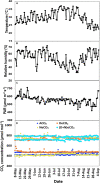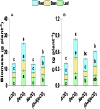Daytime, Not Nighttime, Elevated Atmospheric Carbon Dioxide Exposure Improves Plant Growth and Leaf Quality of Mulberry (Morus alba L.) Seedlings
- PMID: 33613585
- PMCID: PMC7890035
- DOI: 10.3389/fpls.2020.609031
Daytime, Not Nighttime, Elevated Atmospheric Carbon Dioxide Exposure Improves Plant Growth and Leaf Quality of Mulberry (Morus alba L.) Seedlings
Abstract
Almost all elevated atmospheric CO2 concentrations (eCO2) studies have not addressed the potential responses of plant growth to different CO2 in daytime and nighttime. The present study was to determine the impact of daytime and/or nighttime eCO2 on growth and quality of mulberry (Morus alba L.), a perennial multipurpose cash plant. Six-month-old mulberry seedlings were hence grown in environmentally auto-controlled growth chambers under four CO2 concentrations: (1) ambient CO2 (ACO2, 410 μmol mol-1 daytime/460 μmol mol-1 nighttime), (2) sole daytime elevated CO2 (DeCO2, 710 μmol mol-1/460 μmol mol-1), (3) sole nighttime elevated CO2 (NeCO2, 410 μmol mol-1/760 μmol mol-1), and (4) continuous daytime and nighttime elevated CO2 (D + NeCO2, 710 μmol mol-1/760 μmol mol-1). Plant growth characteristics, nutrient uptake, and leaf quality were then examined after 120 days of CO2 exposure. Compared to control, DeCO2 and (D + N)eCO2 increased plant biomass production and thus the harvest of nutrients and accumulation of leaf carbohydrates (starch, soluble sugar, and fatty acid) and N-containing compounds (free amino acid and protein), though there were some decreases in the concentration of leaf N, P, Mg, Fe, and Zn. NeCO2 had no significant effects on leaf yield but an extent positive effect on leaf nutritional quality due to their concentration increase in leaf B, Cu, starch, and soluble sugar. Meanwhile, (D + N)eCO2 decreased mulberry leaf yield and harvest of nutritious compounds for silkworm when compared with DeCO2. The reason may be associated to N, P, Mg, Fe, and Zn that are closely related to leaf pigment and N metabolism. Therefore, the rational application of mineral nutrient (especially N, P, Fe, Mg, and Zn) fertilizers is important for a sustainable mulberry production under future atmosphere CO2 concentrations.
Keywords: CO2 enrichment; biomass production; free amino acid; mineral elements; nutrient use efficiency.
Copyright © 2021 Shi, Qiu, Wen, Xu, Dong, Xu and He.
Conflict of interest statement
The authors declare that the research was conducted in the absence of any commercial or financial relationships that could be construed as a potential conflict of interest.
Figures





Similar articles
-
Greater Biomass Production Under Elevated CO2 Is Attributed to Physiological Optimality, Trade-Offs in Nutrient Allocation, and Oxidative Defense in Drought-Stressed Mulberry.Antioxidants (Basel). 2025 Mar 25;14(4):383. doi: 10.3390/antiox14040383. Antioxidants (Basel). 2025. PMID: 40298623 Free PMC article.
-
Funneliformis mosseae Improves Growth and Nutrient Accumulation in Wheat by Facilitating Soil Nutrient Uptake under Elevated CO2 at Daytime, Not Nighttime.J Fungi (Basel). 2021 Jun 7;7(6):458. doi: 10.3390/jof7060458. J Fungi (Basel). 2021. PMID: 34200509 Free PMC article.
-
Differential responses in photosynthesis, growth and biomass yields in two mulberry genotypes grown under elevated CO2 atmosphere.J Photochem Photobiol B. 2015 Oct;151:172-9. doi: 10.1016/j.jphotobiol.2015.08.008. Epub 2015 Aug 14. J Photochem Photobiol B. 2015. PMID: 26298067
-
Impacts of elevated CO2 on plant resistance to nutrient deficiency and toxic ions via root exudates: A review.Sci Total Environ. 2021 Feb 1;754:142434. doi: 10.1016/j.scitotenv.2020.142434. Epub 2020 Sep 21. Sci Total Environ. 2021. PMID: 33254908 Review.
-
Temporal variability in tree responses to elevated atmospheric CO2.Plant Cell Environ. 2021 May;44(5):1292-1310. doi: 10.1111/pce.13986. Epub 2021 Jan 9. Plant Cell Environ. 2021. PMID: 33368341 Review.
Cited by
-
Identification of metabolic and protein markers representative of the impact of mild nitrogen deficit on agronomic performance of maize hybrids.Metabolomics. 2024 Nov 9;20(6):128. doi: 10.1007/s11306-024-02186-z. Metabolomics. 2024. PMID: 39520587 Free PMC article.
-
Arbuscular Mycorrhization Enhances Nitrogen, Phosphorus and Potassium Accumulation in Vicia faba by Modulating Soil Nutrient Balance under Elevated CO2.J Fungi (Basel). 2021 May 5;7(5):361. doi: 10.3390/jof7050361. J Fungi (Basel). 2021. PMID: 34063150 Free PMC article.
-
Greater Biomass Production Under Elevated CO2 Is Attributed to Physiological Optimality, Trade-Offs in Nutrient Allocation, and Oxidative Defense in Drought-Stressed Mulberry.Antioxidants (Basel). 2025 Mar 25;14(4):383. doi: 10.3390/antiox14040383. Antioxidants (Basel). 2025. PMID: 40298623 Free PMC article.
-
Bioactive Compounds Produced in Leaves of Mulberry (Morus alba L.) Transplants under Modified Environments of Root and Aerial Zones.Plants (Basel). 2022 Oct 26;11(21):2850. doi: 10.3390/plants11212850. Plants (Basel). 2022. PMID: 36365301 Free PMC article.
-
Funneliformis mosseae Improves Growth and Nutrient Accumulation in Wheat by Facilitating Soil Nutrient Uptake under Elevated CO2 at Daytime, Not Nighttime.J Fungi (Basel). 2021 Jun 7;7(6):458. doi: 10.3390/jof7060458. J Fungi (Basel). 2021. PMID: 34200509 Free PMC article.
References
-
- Amthor J. S. (2001). Effects of atmospheric CO2 concentration on wheat yield: review of results from experiments using various approaches to control CO2 concentration. Field Crops Res. 73 1–34. 10.1016/s0378-4290(01)00179-4 - DOI
LinkOut - more resources
Full Text Sources
Other Literature Sources
Miscellaneous

